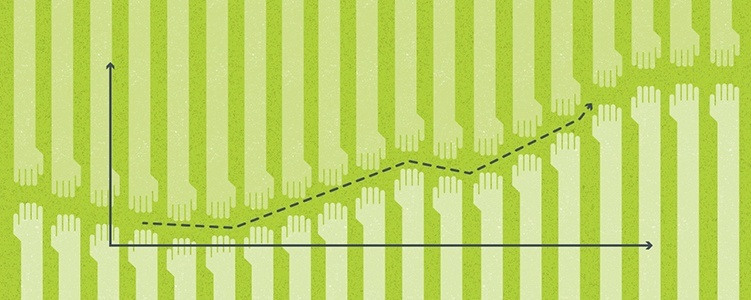In the past, employee engagement was viewed as a “reactive” measure. Engagement was seen as a way to help solve employment issues such as turnover, low morale, and labor relations claims. But, as US businesses lose about $11 billion annually due to employee turnover HR can’t sit by and wait for the next issue to solve. We need to be proactive. This means understanding what employee engagement is and implementing the right program to keep organizations ahead of the engagement curve.
How do you keep employees ahead of the engagement curve? You can start by
1. Helping management understand the value of engagement.
2. Taking action based on employee survey results.
3. Training supervisors how to keep employees engaged.
The Value of Engagement
It’s true; engaged employees are more fulfilled and more productive, but changes in productivity that result from engagement can be difficult to measure quickly. Instead of looking for instantaneous data to support engagement, consider employee engagement as more of a business imperative, rather than just a “nice to have.”
Numerous studies show that positive engagement experiences produce positive business results. The research supports the argument that an investment in employee engagement initiatives can lead to better business outcomes. So, running business goals parallel with employee engagement programs can help managers get ahead of the engagement curve.
I spoke with Jeff Waldman, HR Technology Strategist, about his take on engagement and the resulting business impact. His focus centered on a positive correlation between the strength of your bottom line and the level of employee engagement. Here’s what he said:
“Take a close look at your favorite brands. You like them. You associate with them. You’re emotionally connected. When you’re emotionally and positively connected to something, you become an advocate for it. The same holds true for employer brands. High employee engagement positively impacts your bottom line. Think about it. If your employees are feeling good about themselves at work, feeling appreciated for the hard work they do, and are tightly connected to their purpose at work, they will exert discretionary effort and go the extra mile. The next time you question the validity of employee engagement, think about what makes your business tick. It’s people... your people... the face of your organization.”
Employee Survey Results
If you offer employees the chance to voice their opinions and thoughts on what works and what doesn’t but fail to provide follow-through, employees will stop being thoughtful and stop sharing. To fully understand what engages your employees, take the time to listen and follow it up with actions that can be seen and heard. If we don’t listen, what’s the point?
I spoke with Tim Baker, CHRL, Consultant and Coach, about employee surveys. Do they really work? Are organizations really listening? Here’s what Tim had to say:
“Engagement is as much about an individual's own well-being as it is their commitment to the organization's goals and values. Employee surveys are a fantastic opportunity to find out what people really want from their workplace. If they’ve taken the time to tell you what they want then make sure you take action but provide follow up questions as well.”
Tim suggests following these steps:
1. Begin having more frequent and meaningful conversations with your teams.
2. Determine needs and set goals to address those needs.
3. Use discussions to target business expectations and then align appropriately.
4. Be more agile in your business decisions with a willingness to adapt as needed.
Best practice? Tim mentioned delivering employee surveys to a few people at a time throughout the year works best. You can act on their feedback in small chunks, rather than feeling overwhelmed with a laundry list of items. Start small and follow up. Remember, an engaged employee will impact all aspects of your business.
Tweet: Remember, an engaged employee will impact all aspects of your business @HRCloud
Training Supervisors
You may have the best engagement program in place, but without the right training and support, it might as well be left on the shelf. Your program is only as good as those running it. Take the time to get leadership buy-in before launching something new, and organize a training strategy that will get everyone on the same page.
A 2012 study explored key drivers of employee engagement and reaffirmed the importance of an employee’s relationship with his or her direct manager. The relationship can either make or break an employee’s feeling about work and therefore have a direct impact on productivity, performance, loyalty and creativity. You’ve heard the saying, “An employee leaves his manager, not his organization.” Well, this is a result of poor relationships that damage what could have otherwise been a fruitful partnership.
The study pointed out, “The attitude and actions of the immediate supervisor can enhance employee engagement or can create an atmosphere where an employee becomes disengaged. In addition, employees said that believing in the ability of senior leadership to take their input, lead the company in the right direction and openly communicate the state of the organization is key in driving engagement.”
Engagement doesn’t just happen automatically. You, as an human resources professional, can help stimulate employee engagement at your company. Start by helping managers understand the value of engagement, listening to employees’ needs, and then acting by training supervisors to drive employee engagement.
Keep Reading
Balancing Technology and the Human Touch in Employee Engagement
Companies are taking employee engagement very seriously because it is one of the ways of
Building Strong Teams: The Power of Team Bonding Exercises
Never overestimate the power of collaboration as a core element of effective team


